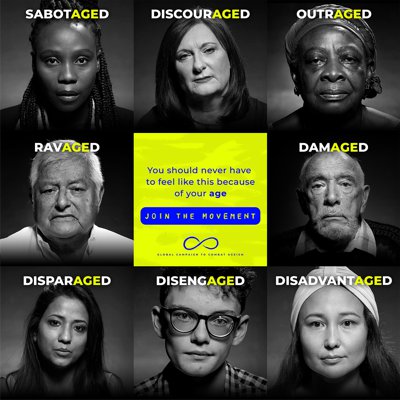By Helen Hirsh Spence
Ageism, unlike other discriminatory practices that have already been identified as toxic, is finally coming of age! The World Health Organization, the Office of the High Commissioner of Human Rights, the United Nations Department of Economic and Social Affairs and the United Nations Population Fund released an evidence-based research report on the impacts of ageism on March 18. As a consequence, a long awaited, global anti-ageism campaign was launched calling for a world for all ages (#AWorld4AllAges).
Ageism affects both young and old; it is defined as the prejudice, stereotype, and discrimination directed towards others, and oneself, based on age. Unfortunately, ageism has been more socially accepted than any other bias and has been extremely slow to gain traction among businesses, corporations, and organizations, even those that pride themselves on “diversity, equity and inclusion” strategies and policies. Although age intersects with all other “isms”, it has been mostly ignored. Whether an individual is black, gay, or Muslim, she will also age. It’s the one area that we all have in common. From the moment we are born until we die, we all age, and yet it has been largely overlooked… until now.
The 2020s have been identified as the decade of healthy ageing by the UN. It is a fitting description, given that globally two people are turning 65 every second and one out of every two persons is biased against older people.
The 1960s and 70s generation of youth who so actively fought for civil rights, demonstrated against the Viet Nam war, burned their bras as the first wave of feminism took shape, have now all entered their 60s and 70s. They are highly educated, technologically savvy, multi-ethnic, and hold most of the buying power in the G7 economies. It’s not really a mystery why ageism has finally appeared on the world’s agenda.
Despite this reality, North Americans are still very much in denial. They continue to refer to gray tsunamis and seniors’ moments, and they maintain idolization of youth. This anti-ageing phenomenon is still prevalent today in advertising, the movies, TV, and the news. Although it is gently changing, anti-ageing dogma has been acceptable for so long that it is hard not to have internalized ageist beliefs. It has been institutionalized to such an extent that it is often not even recognizable.
COVID-19 has illuminated some of the dire consequences of having relegated the more vulnerable, older persons to inadequate care with less than standard health care options. It has added to the isolation and loneliness factor, resulting in premature deaths, and has dramatically diminished the quality of life of older citizens.
Ageism has extremely negative outcomes. It contributes to poorer physical and mental health, cognitive decline, shorter lifespans, and slower recovery from illness. Although ageism towards older adults is more prevalent, it has negative consequences for young adults as well. Both ends of the age spectrum suffer when discriminated against.
Fortunately, resources to fight ageism are also becoming more mainstream. There is acknowledgement that policies and laws that address ageism need to be enforced and monitored. Awareness and educational programs need to be developed to counter negative age perceptions that start as early as four years of age. Finally, age segregation or age silo-ing has to be eliminated by bringing generations together to foster mutual understanding and empathy. These are the challenges that we all face as members of a society that has tolerated ageism for too long.
Join the movement! Please find resources and references for your fight against ageism below.
Visit the World Health Organization Global Report on Ageism webpage to download the full Global Report on Ageism (202 pages), the Summary Report (5 pages), and to access the Report’s launch event recording, along with numerous resources, Watch the Report’s launch video here.
- Top Sixty Over Sixty, Ageism
- Top Sixty Over Sixty, Nine Solutions to Deal with Eight Older Worker Stereotypes
- Top Sixty Over Sixty, Every AGE Counts, Australia’s campaign to tackle ageism
- World Health Organization, Global campaign to combat ageism toolkit
- World Health Organization, Initiating a conversation about ageism
- World Health Organization, Summary Slides: Global report on ageism
- World Health Organization, Campaigning to tackle ageism
- Age Equity Alliance, click here

